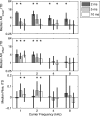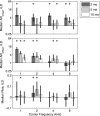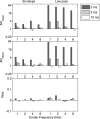Temporal weighting functions for interaural time and level differences. IV. Effects of carrier frequency
- PMID: 25480069
- PMCID: PMC4257961
- DOI: 10.1121/1.4900827
Temporal weighting functions for interaural time and level differences. IV. Effects of carrier frequency
Abstract
Temporal variation in listeners' sensitivity to interaural time and level differences (ITD and ILD, respectively) was measured for sounds of different carrier frequency using the temporal weighting function (TWF) paradigm [Stecker and Hafter (2002) J. Acoust. Soc. Am. 112,1046-1057]. Listeners made lateralization judgments following brief trains of filtered impulses (Gabor clicks) presented over headphones with overall ITD and/or ILD ranging from ±500 μs ITD and/or ±5 dB ILD across trials. Individual clicks within each train varied by an additional ±100 μs ITD or ±2 dB ILD to allow TWF calculation by multiple regression. In separate conditions, TWFs were measured for carrier frequencies of 1, 2, 4, and 8 kHz. Consistent with past studies, TWFs demonstrated high weight on the first click for stimuli with short interclick interval (ICI = 2 ms), but flatter weighting for longer ICI (5-10 ms). Some conditions additionally demonstrated greater weight for clicks near the offset than near the middle of the train. Results support a primary role of the auditory periphery in emphasizing onset and offset cues in rapidly modulated low-frequency sounds. For slower modulations, sensitivity to ongoing high-frequency ILD and low-frequency ITD cues appears subject to recency effects consistent with the effects of leaky temporal integration of binaural information.
Figures










Similar articles
-
Temporal weighting functions for interaural time and level differences. III. Temporal weighting for lateral position judgments.J Acoust Soc Am. 2013 Aug;134(2):1242-52. doi: 10.1121/1.4812857. J Acoust Soc Am. 2013. PMID: 23927122 Free PMC article.
-
Temporal weighting of interaural time and level differences in high-rate click trains.J Acoust Soc Am. 2010 Jul;128(1):332-41. doi: 10.1121/1.3436540. J Acoust Soc Am. 2010. PMID: 20649228 Free PMC article.
-
Temporal weighting functions for interaural time and level differences. II. The effect of binaurally synchronous temporal jitter.J Acoust Soc Am. 2011 Jan;129(1):293-300. doi: 10.1121/1.3514422. J Acoust Soc Am. 2011. PMID: 21303010 Free PMC article.
-
Spectrotemporal weighting of binaural cues: Effects of a diotic interferer on discrimination of dynamic interaural differences.J Acoust Soc Am. 2016 Oct;140(4):2584. doi: 10.1121/1.4964708. J Acoust Soc Am. 2016. PMID: 27794286 Free PMC article.
-
[Sound localization cues of binaural hearing].Laryngorhinootologie. 2003 Apr;82(4):240-8. doi: 10.1055/s-2003-38932. Laryngorhinootologie. 2003. PMID: 12717598 Review. German.
Cited by
-
Sound source localization identification accuracy: Level and duration dependencies.J Acoust Soc Am. 2016 Jul;140(1):EL14. doi: 10.1121/1.4954870. J Acoust Soc Am. 2016. PMID: 27475204 Free PMC article.
-
The precedence effect in spatial hearing manifests in cortical neural population responses.BMC Biol. 2022 Feb 16;20(1):48. doi: 10.1186/s12915-022-01228-z. BMC Biol. 2022. PMID: 35172815 Free PMC article.
-
Sensitivity to Envelope Interaural Time Differences at High Modulation Rates.Trends Hear. 2015 Dec 30;19:2331216515619331. doi: 10.1177/2331216515619331. Trends Hear. 2015. PMID: 26721926 Free PMC article.
-
Effect of Realistic Test Conditions on Perception of Speech, Music, and Binaural Cues in Normal-Hearing Listeners.Am J Audiol. 2023 Mar;32(1):170-181. doi: 10.1044/2022_AJA-22-00143. Epub 2022 Dec 29. Am J Audiol. 2023. PMID: 36580493 Free PMC article.
-
Sub-optimal construction of an auditory profile from temporally distributed spectral information.J Acoust Soc Am. 2021 Mar;149(3):1567. doi: 10.1121/10.0003646. J Acoust Soc Am. 2021. PMID: 33765831 Free PMC article.
References
-
- Akeroyd, M. A. (2001). “ A binaural cross-correlogram toolbox for MATLAB,” Technical Report, University of Connecticut Health Center/University of Sussex, software downloadable from http://www.ihr.mrc.ac.uk/projects/matlab/binaural_toolbox (Last viewed 10 Oct. 2014).
Publication types
MeSH terms
Grants and funding
LinkOut - more resources
Full Text Sources
Other Literature Sources
Miscellaneous

